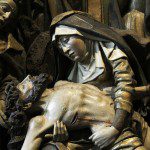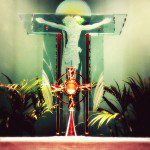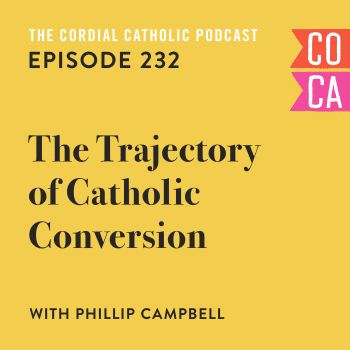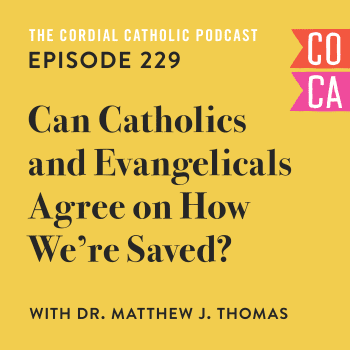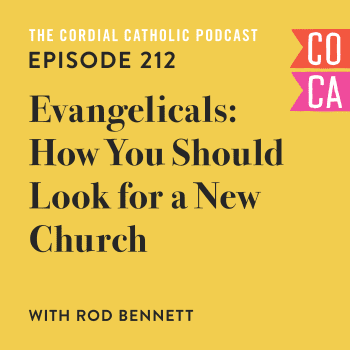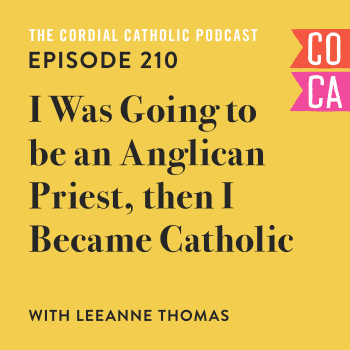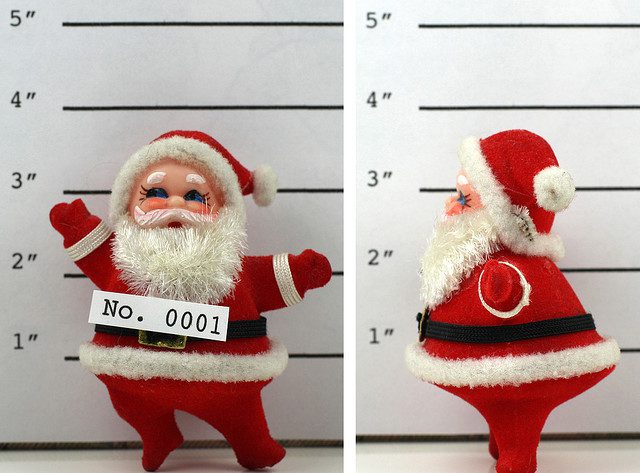
I never, for even a second, want to diminish my spiritual journey as a Protestant. It’s been, as they say, fifteen good years. I appreciate every minute of it. It was all a learning experience and I’ve learned a lot. And of course there’s value in where I was—in where I’ve been—the only difference is that I’m finding more value, at least for myself, in where I’m going. That’s, of course, why I’m going there.
It’s difficult to move away from something and not make it sound like it wasn’t good enough, or that something had gone wrong with it. For me, I’ve found something more, and I’m not alone, but not everyone finds fulfillment in what I find fulfillment in. It won’t make sense for everyone like it’s made sense for me. If there was really no debate and no difficulties with Catholicism then we would all be Catholics—likewise for Protestantism or the Eastern Orthodox tradition.
I never, ever, want to put my previous faith traditions down, or anyone else’s. But I do want to say, with breathless excitement, what I’ve experienced in my first Catholic Christmas, as a Protestant.
I’ve been walking through Catholic Christmas celebrations this year, as a Protestant, and it’s been incredible. I join the Catholic Church at Easter, barring any widespread apocalyptic scenario, so my participation has been a different sort than it would be as a full member of the Catholic Church but it’s been no less exciting, and fascinating, and mind-bogglingly more rich and rewarding than I imagined it could’ve been.
Growing up in my faith we didn’t have a lot of Christmas traditions. We were Pentecostal, practising more like Baptists, and although we did have a Christmas Eve service like any good Bapticostal church, Christmas wasn’t the same kind of anticipatory, penitential season as it is in the Catholic Church. Unlike more traditional, mainline churches, we sang Christmas carols beginning on December 1st. Our annual Christmas musical, a dramatic, song-filled retelling of the birth of Jesus, was held in mid-December. The season was Christmas and it was a month long, ending precisely on December 26.
My experience of Christmas has been a bit different, more recently, as the non-denominational church we attend, and love, has embraced a more traditional take on the season. We celebrate Advent in a way similar to other mainline churches with an Advent Wreath and a moratorium on Christmas carols until Christmas Eve. We follow the Common Lectionary too, which I obviously love, and the readings follow the common thread, the rhythm, of the season of Advent.
Recently then, Christmas, and Advent, have been more of the sort of anticipatory season I imagined it being within the Catholic Church so I was amazed, and excited, by the even deeper meaning and richness I’ve found now that I’ve slipped through the doors and snuck into the pews of Catholic churches.
In the Catholic Church Advent, the time leading up to Christmas, in addition to being an anticipatory season is also a kind of penitential season, like Lent. It’s a time to examine ourselves and live within the awareness that Christ is coming, in the form of a helpless baby, to redeem us from ourselves. I absolutely love the phrase in O Holy Night, “A thrill of hope, the weary world rejoices.”
We are, as Christians, part and parcel of this “weary world.” We’re in this weary world but not of it and so we, in a special way, await the coming of the Christ child (and His return again) to redeem the desperate and disappointed creation all around us. The weary world.
Advent is a season for solemn reflection, and breathless anticipation, and Catholics do it right. The readings, the structure of the Mass on a Sunday, the increased opportunities for confession and penitential services all set the tone for the coming of Christ. We a broken. We are excited to be fixed.
Then there’s a story.
I’m learning this: That there is a distinct and beautiful rhythm to the Catholic liturgical year. There are seasons and, in the time of Advent, Christmas, and the days beyond, there is rich and meaningful story. I should say, poetry, woven into the daily life of the practising Catholic.
Christmas, for the Catholic, is more than just one day. Liturgically speaking (and oh how I love to speak liturgically, lately, to anyone who will listen) the season of Christmas is actually an octave, which is eight days long. I think, unofficially, it ends later than that, 12 days, I believe, at the Feast of the Epiphany. And here’s what I mean by story.
The readings, the prayers, the hymns and music, and the priest’s homily follow the story of Christmas. Leading up to Christmas, during Advent, we read from the gospels accounts of Mary and Elizabeth, John the Baptist and the prophesies concerning Jesus. It’s a time of anticipation and then, like the striking of a match in a dark room, the Mass on Christmas Eve (or Christmas Day) opens with this text, from Isaiah 9:2,
The people who walked in darkness
have seen a great light.
The match is struck. Powerful stuff.
But the story continues. In the Christmas octave, and beyond, we trace Jesus’ presentation at the Temple, we remember King Herod’s slaughter of the innocents in his quest to kill the newborn “King of the Jews,” and we end up at the Epiphany, when God revealed the newborn Jesus to the world through the Wise Men from the East.
At each turn, like a wave upon a wave, the readings and prayers and homilies during this season reflect the ongoing narrative. The life and the prayer of the Church, then, serves as a beautiful mirror of the story of the life of Christ. A living reminder.
And one more thing.
As a Protestant, peeking in the curtain at the Catholic Church at Christmas there was something else that struck me in a powerful way and that’s the closeness of the Christmas story. Here’s what I mean.
In the Catholic Church’s understanding of the Communion of the Saints, it’s held that the saints are with us, among us, like great witnesses who are, also, praying at the altar in Heaven. This is pictured in Relevation which isn’t, to the Catholic theologian, just a book about the end of the world. Catholics believe that saints are in Heaven, in prayer, and that they want to pray for us. We can join our prayers with those who have gone before us—those who are, presently, in the incredible presence of God.
That right there is, like, wow for me.
But in all seriousness this is another aspect that struck me, deeply, about Christmas for the Catholic. If the saints are with us and among us, especially when we’re celebrating the Lord’s Supper, then that means those we talk about, read about, and hear about during the Christmas season are with us in prayer. Get out of town.
Catholics can join in prayer with Mary, Joseph, Elizabeth, Zechariah, John the Baptist—the whole cast of characters!
For the Catholic, Christmas isn’t simply commemorating the birth of Jesus in a really interesting and rich way. The Catholic, I’ve learned first hand, can truly be taking part in the whole narrative in a way that I could never dream of, nor would I have, as a Protestant. Catholics don’t believe that the cast of characters associated with Jesus’ miraculous birth—the coming of the God Man—are simply dead and gone but they are living, through Christ, in Heaven, and surround the altar of God joining their prayers with ours, like incense wafting up from the earth.
The living narrative being retold for two thousand years is wholly close, and real, in the union of prayer that we can have with those who were right there, and lived it out. The weary world, rejoicing.
This article was originally published on my personal blog in January of 2015.

